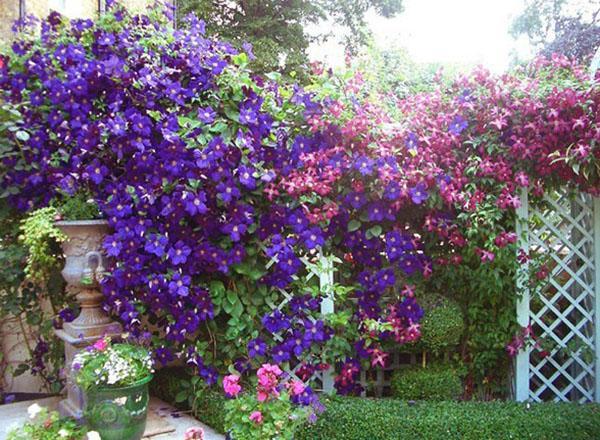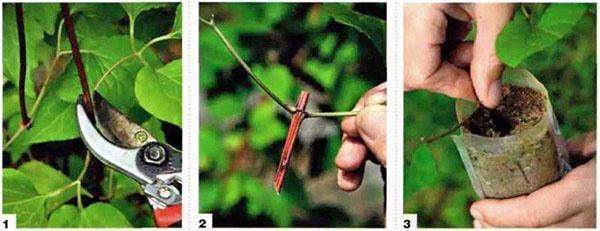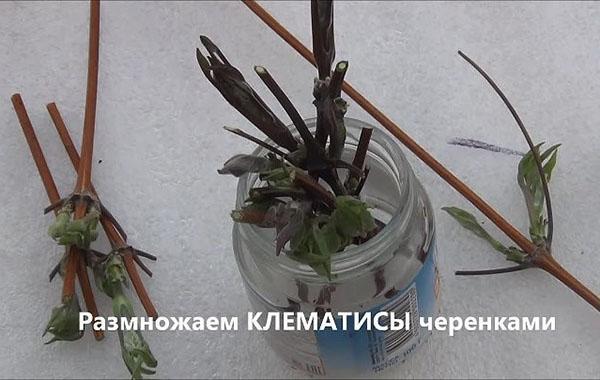Successful propagation of clematis by cuttings
 Amateur gardeners and professional gardeners pay special attention to such an important process as the propagation of clematis by cuttings. It is this method that makes it possible to obtain several more copies of your favorite plant variety. The process is quite easy and fast, if you consider some important points and tips. When the cuttings are successful, beautiful young clematis grow.
Amateur gardeners and professional gardeners pay special attention to such an important process as the propagation of clematis by cuttings. It is this method that makes it possible to obtain several more copies of your favorite plant variety. The process is quite easy and fast, if you consider some important points and tips. When the cuttings are successful, beautiful young clematis grow.
Reproduction of clematis by cuttings at different times of the year
Obtaining new clematis bushes can be carried out all year round: in spring and autumn, winter and summer.
Cutting clematis in autumn

 By the end of summer, a young clematis bush will grow. It is important to ensure that the earth does not dry out.
By the end of summer, a young clematis bush will grow. It is important to ensure that the earth does not dry out.
Attention is needed to the temperature regime for the plant to take well.
Winter cuttings of clematis
For winter cuttings, the use of woody branches is characteristic. This is necessary in order to increase the chance of survival of cuttings during the cold winter, when sunlight contains fewer nutrients.
The stalk should be small (less than twenty centimeters) so that it is convenient to make a small greenhouse for it. This will provide the young plant with warmth and moderate moisture.
Cuttings are less likely to be accepted and require more care.
Reproduction of clematis cuttings in spring
 To get cuttings, you need to cut off a shoot of at least 70 centimeters from the bush. The upper part of the branch is not needed, since this is the unripe part of the shoot, the buds are not laid in the leaf axils here.
To get cuttings, you need to cut off a shoot of at least 70 centimeters from the bush. The upper part of the branch is not needed, since this is the unripe part of the shoot, the buds are not laid in the leaf axils here.
It is best to take cuttings from the middle part, which do not have large green shoots.
When cutting cuttings, about 7 centimeters are left. After that, the cuttings are placed in a solution of heteroauxin or root for half an hour. This stimulates the emergence of the root system. This makes clematis propagation by cuttings more efficient.
The earth can be loosened flat cutter, add humus so that the earth is fertile and soft. A groove is created, spilled with water. After the water is partially absorbed, the hole is partially covered with earth. Cuttings are inserted there up to the very sprouts.
How to properly cut clematis cuttings:
- Use a sharp knife. Secateurs can crush and damage delicate, thin twigs. A sharp knife will not spoil the cuttings.
- Cut at a 45 degree angle. You need to cut the shoot obliquely, ideally at an angle of 45 degrees. With the help of such pruning, the area of root appearance is increased.
- Pull back 1.5 centimeters. For a successful cut of cuttings, you need to retreat 1.2 - 2 centimeters from the nodule.
Cuttings are well accepted from both old and young shrubs.
How clematis reproduces by cuttings in summer
 Reproduction of this plant is very simple. There is no need to use additional materials.
Reproduction of this plant is very simple. There is no need to use additional materials.
When grafting, half or a third of the leaf should be cut off, since it is in the summer that large leaves bloom at clematis.
A video about cutting clematis in the summer will tell you many important points that you should listen to and see with your own eyes. The video has a lot of tips for proper plant care. There are especially many nuances during the summer period. It is necessary to ensure that the cuttings do not dry out, like the earth in which they are located.
Cuttings are going well. By the next season, young and beautiful clematis grow.
Reproduction of clematis by cuttings in water
 This method follows a similar principle.
This method follows a similar principle.
It is worth considering several important factors that prevent possible errors (rotting of cuttings):
- Clean container. It is very important that the container in which the cuttings will grow is perfectly clean. This is the main mistake after which the cuttings deteriorate and rot.
- High-quality cut. A smooth and neat cut is a guarantee of a well-developing root system. A bad cut can ruin the plant.
A sharp tool is used for work.
If you are interested in the question of how to grow clematis from a cuttings, then there is one good advice.
When rooting, plants secrete a liquid that contains natural root-forming substances. If the gardener has grown cuttings in water before, then it is good to add liquid from previous cuttings to new plants. This reduces the time for the formation of kalyus and the first grooves of the roots.
As soon as the grooves of the roots appear, the plant can be transplanted into the ground, or you can wait until a full-fledged root grows.
The cutting is transplanted into a small container, which needs to be covered with something on top to create an airtight package. You can take a bottle, cut it into two parts, in one of which you plant a stalk, and on the second you make small cuts from the bottom (thanks to this you can combine the bottles with each other). This is how clematis propagates by cuttings in water.
 A small depression is made in the ground (it is not necessary to stick the cutting directly into the ground, so as not to damage the kalyus), where clematis is then placed.
A small depression is made in the ground (it is not necessary to stick the cutting directly into the ground, so as not to damage the kalyus), where clematis is then placed.
It is advisable to keep the plant at a temperature of 22 ° C, since at a lower temperature the roots either do not grow at all, or grow slowly.
Reproduction of clematis by layering
 Among gardeners, a favorite way to increase the number of plants is to propagate clematis by layering. Unlike grafting, this method gives one hundred percent results, requires less effort.
Among gardeners, a favorite way to increase the number of plants is to propagate clematis by layering. Unlike grafting, this method gives one hundred percent results, requires less effort.
A twig is taken, part of which is buried in the ground (attached with a hairpin or other fastener so that it does not fly away).
This method is good because the mother branch will feed the bush with fashion until it gets strong enough to become independent. From the mother, he receives all the necessary nutrients, trace elements. But this does not mean that the bush itself does not need to be fertilized. He needs the same care as his brethren: adequate watering and good feeding.
Only if all these recommendations are followed will this method become successful.
Reproduction of clematis by green cuttings has several important features. This method is considered quite simple. Even a novice gardener can cope with it, but despite this, experienced gardeners also prefer to breed clematis with cuttings.
This method has several advantages:
- Low cost. With the help of cuttings, you can grow a new plant for free. Seeing a beautiful clematis from a neighbor or friend, you can ask him for a cutting. Then you will be able to grow exactly the same plant at home. At the same time saving both time and money.
- Quantity and quality. Taking cuttings of good varieties, you will grow a plant identical to those from which the fence was taken. With the correct cultivation of cuttings, you can grow an entire garden without buying a single bush or flower.